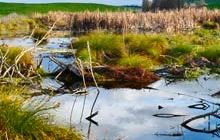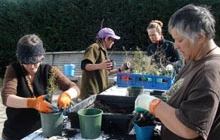Wetlands protection guide
Introduction
Get support on restoring wetlands, and what to plant on your land.That wet, soggy area on land, including farms, can perform many valuable functions, including trapping sediment and filtering nutrient run-off reducing the impact of floods and maintaining water tables.
Rather than draining or infilling wetlands, you can create a sustainable system.
Fencing out the wetland and planting a diversity of native trees and shrubs suited to the wet conditions will add commercial and environmental value.
Plants for wetlands
The water level and how much it fluctuates has a bearing on what plants and animals the wetland can support.
Areas continuously under water to a depth of 1.5 m sustain a variety of sedges and rushes including:
- raupo (Typha orientalis)
- spike rush (Eleocharis Sphacelata)
- lake club rush (Schoenoplectus validus)
- jointed twig rush (Baumea articulata)
Shallower water of 10 to 15 cm depth or water logged soils support:
- umbrella sedges (Cyperus species)
- rushes (Juncus species)
- pukio (Carex secta) and other carex species
- flax (Phormium tenax)
Wetland buffer plants
Around the edges of a wet area where there is permanently damp ground with periodic wetting the following species could be planted:
- toetoe (Cortaderia fulvida)
- cabbage tree (Cordyline australis)
- pukatea (Laurelia novae-zelandiae)
- kahikatea (Dacrycarpus dacrydioides)
- manuka (Leptospernum scoparium)
- mingimingi (Coprosma propinqua and tenuicaulis)
- swamp maire (Szygium mairie)
Some plants are more suited to drier ground e.g.:
- karamu (Coprosma robusta)
- mahoe (Melicytus ramiflorus)
- kowhai (Sophora species)
- ribbonwood (Plagianthus regius)
- kohuhu (Pittosporum tenuifolium)
Choose the right plants for the right place, and group and mix plants informally, for a natural appearance.
Weed control in wetlands
Willows were planted widely in the past, to help with the reclamation and stabilisation of river banks. Two willow species—crack willow and grey willow—have spread widely and are now regarded as invasive weeds. Once established, they quickly become the dominant species, to the detriment of many of our native plants. If willows are invading your wetland, the best way to get rid of them is to drill a hole into the base of the tree and fill it with an appropriate herbicide. The tree will eventually die and rot away, but in the interim will provide shelter for getting native plants established. If you do want to plant willow as food for waterfowl, be sure to choose a sterile form, i.e. the shrubby or booth willow.
Blackberry, broom and other weeds can also be a problem, and a control programme needs to be implemented in the early stages of restoration.
Funding and support
Funding may be available to protect existing wetlands or restoration work on private land. Ask your local DOC office or regional council about current funding available to assist with stream restoration or riparian protection.
The QEII Trust helps private landowners to protect significant natural and cultural features on their land, in perpetuity, through open-space covenants. Contact them for legal protection advice and possible funding for fencing.
More information
On the DOC website
Wetlands habitat
Learn more about wetlands in New Zealand.
Ecological restoration - local planting guides
Find out what to plant and where, and learn what 'eco-sourcing' means.
Wetland resources
Download education kits, teachers' resource kits, information sheets, and publications.
Arawai Kākārikii wetland restoration programme
Learn about this project to restore three wetland sites.
Assessing the impact of the project
Does the project have the potential to impact on natural, historic or cultural values?
DOC’s Inventory and Monitoring Toolbox
This is a selection of standardised methods for sampling populations of species. It's the authoritative source of sampling methods that DOC uses.
On other websites
The National Wetland Trust
For wetlands publications, newsletters and related links
LERNZ Lake Ecosystem Restoration New Zealand
Lake restoration research
Wonderful wetlands - Forest & Bird
Learn why wetlands are one of the most valuable ecosystems.
Regional information
Restoring our biodiversity - Auckland Regional Council
See the Wetlands overview and Wetlands restoration documents for information on planting for wetlands and why they are important.
Restoring Waikato's indigenous biodiversity - Waikato Biodiversity Forum
Find guides to restoring swamps and bogs.
Working with wetlands in Hawke's Bay and the East Coast
Get advice on how landowners can create and restore wetlands.
Wetlands - Bay of Plenty Region
Includes the Wetland Restoration Guide on how to preserve and recreate our wildlife water wonderlands in the Bay of Plenty.
No results


